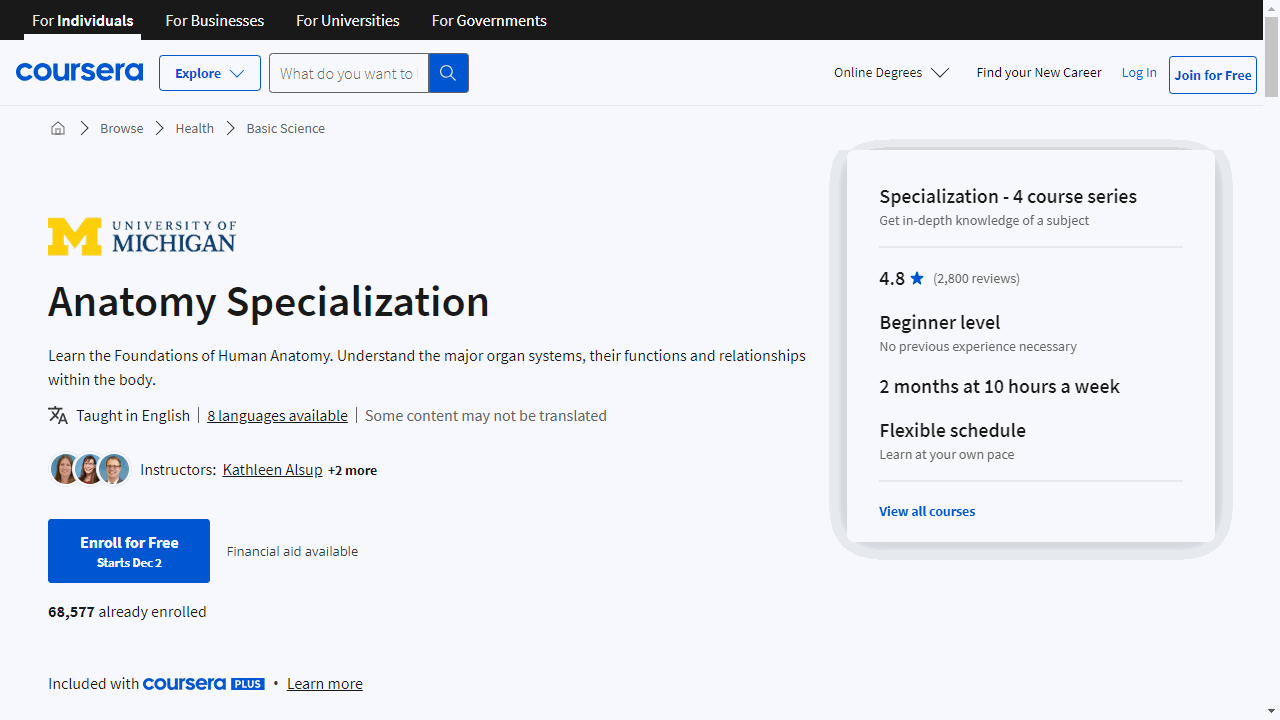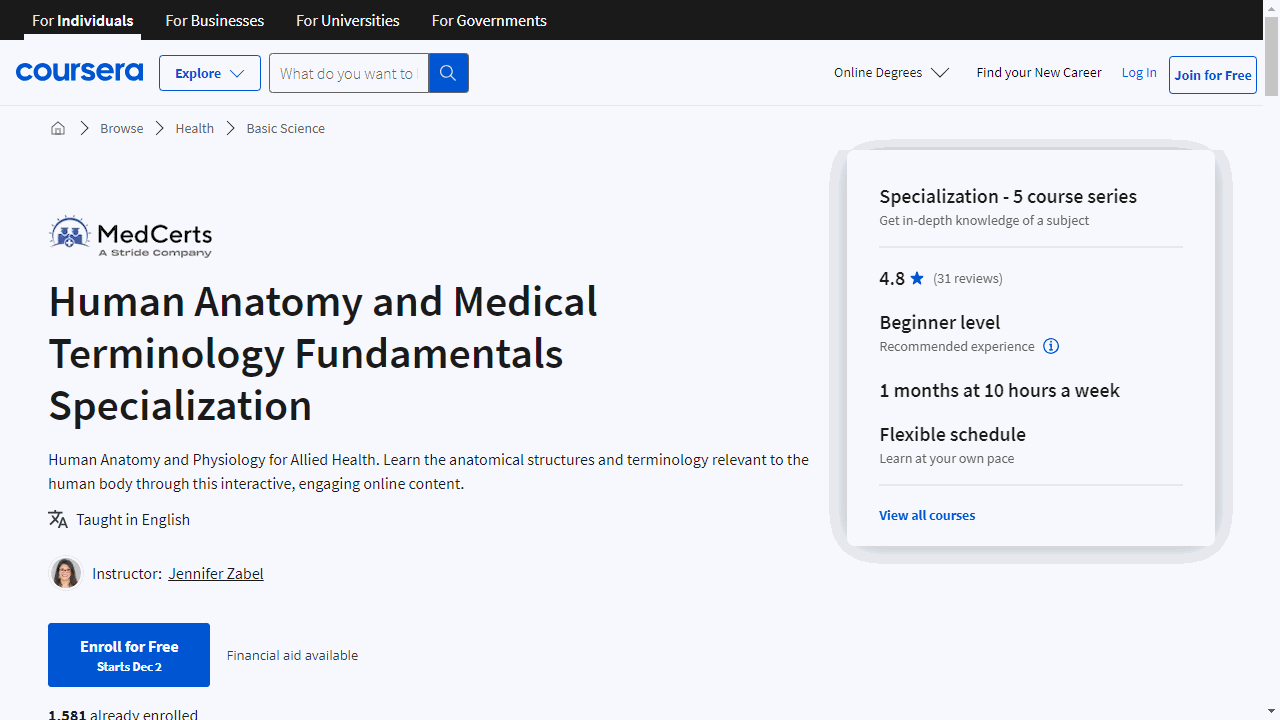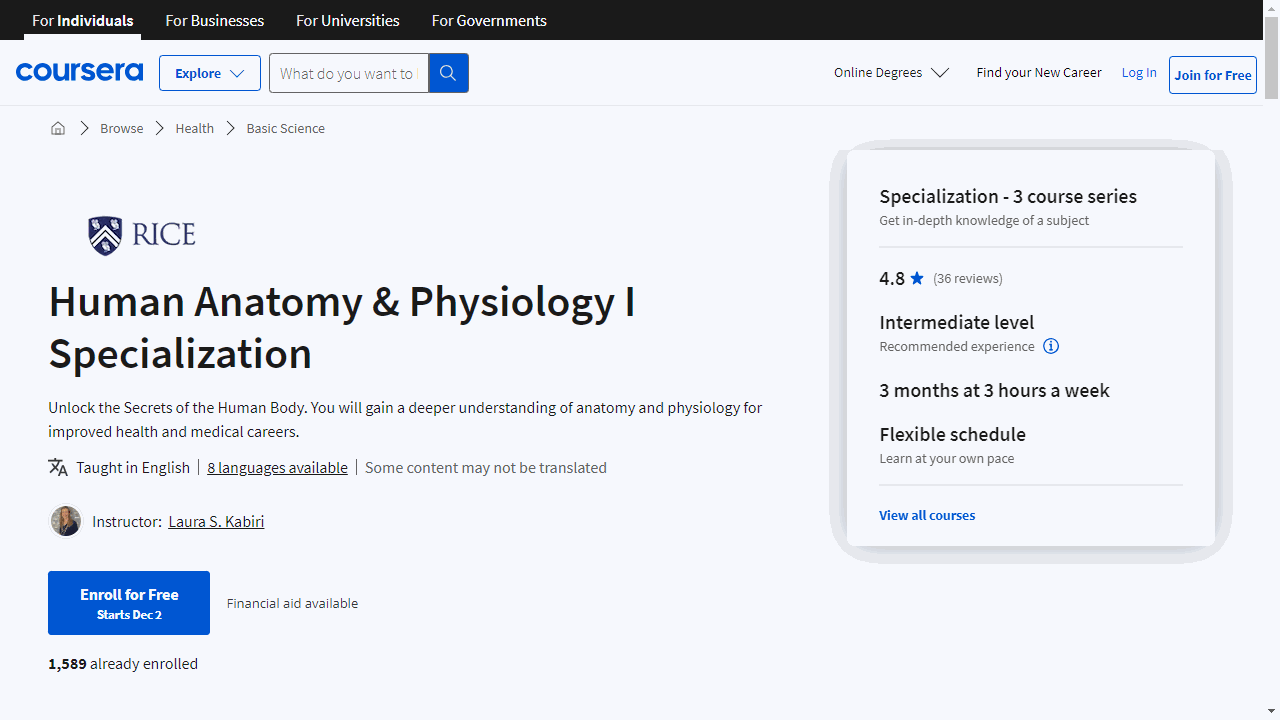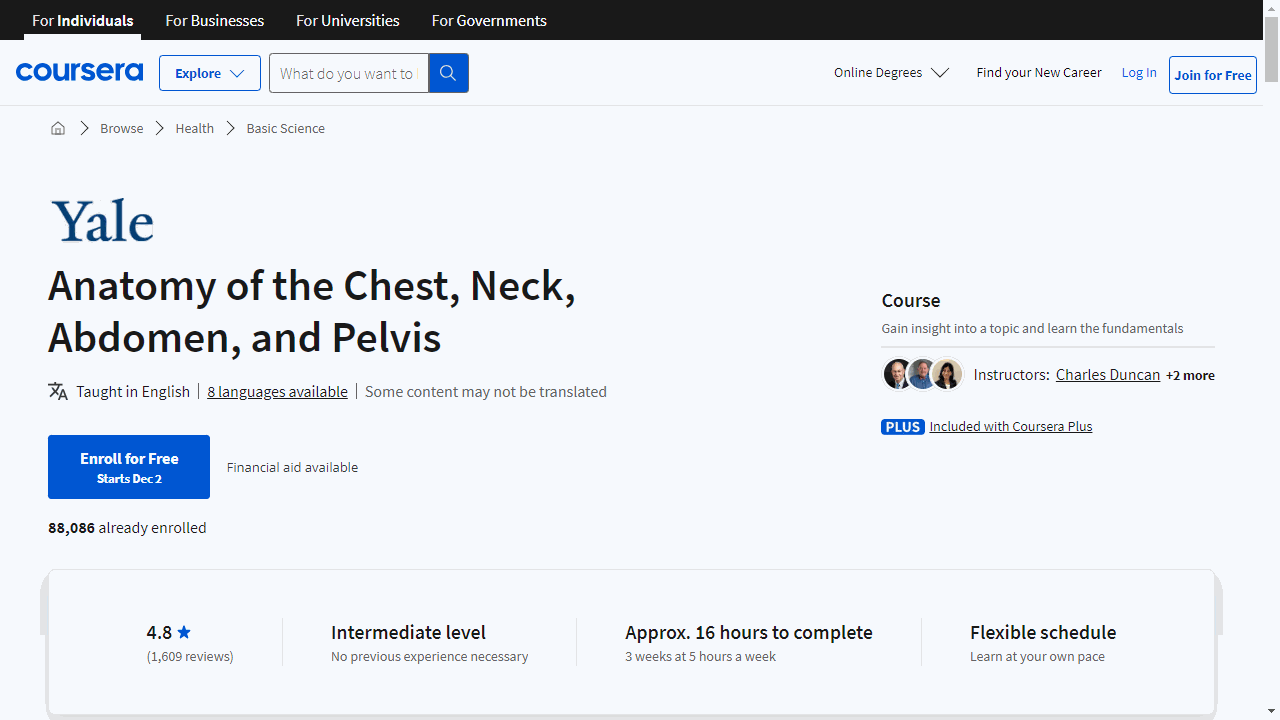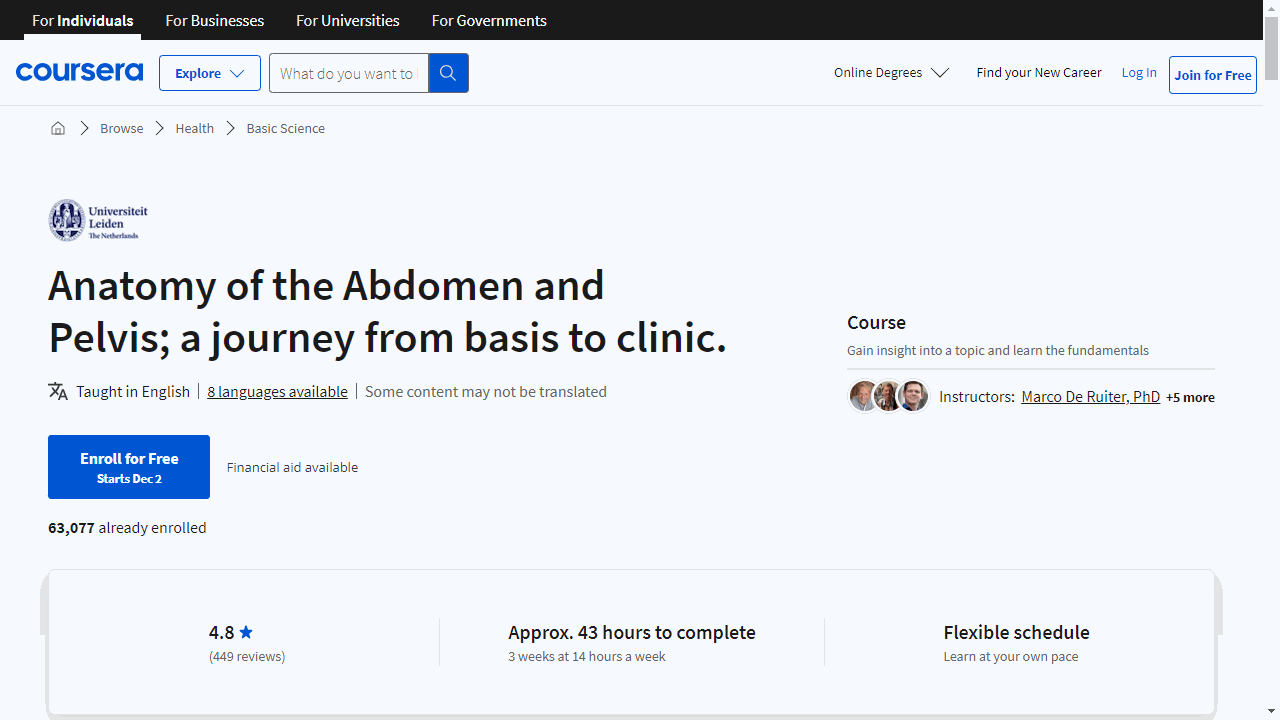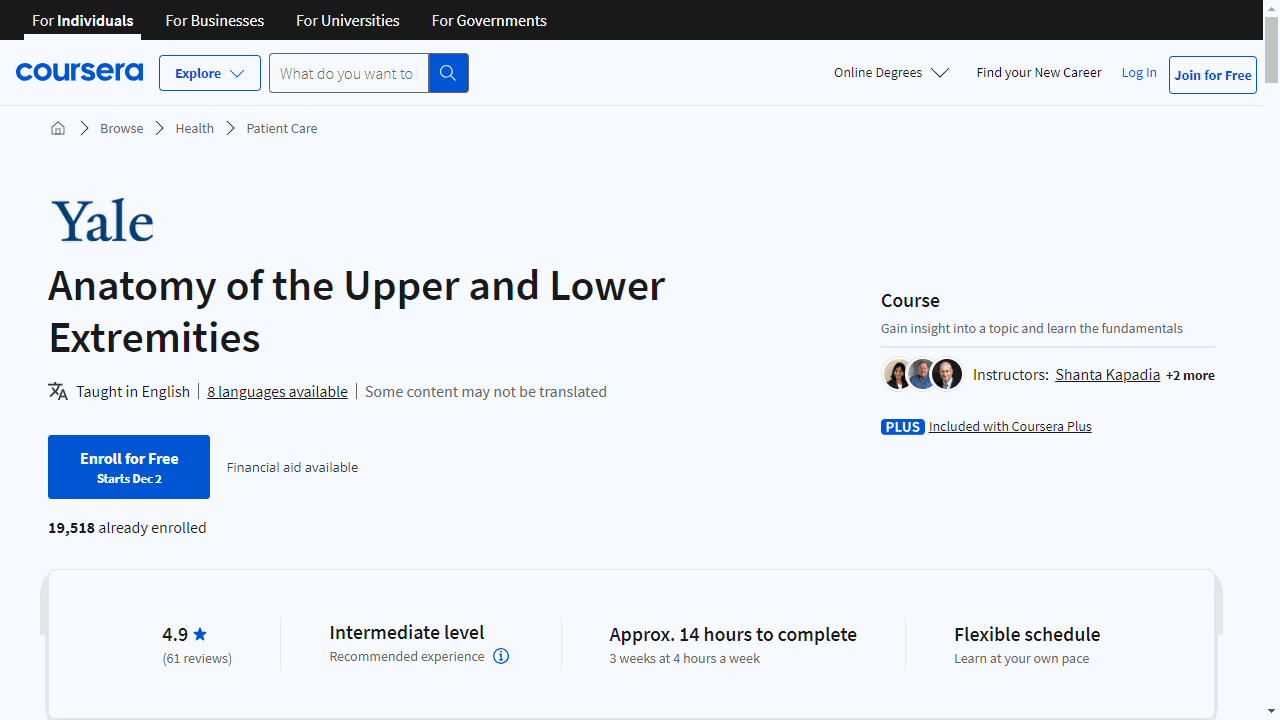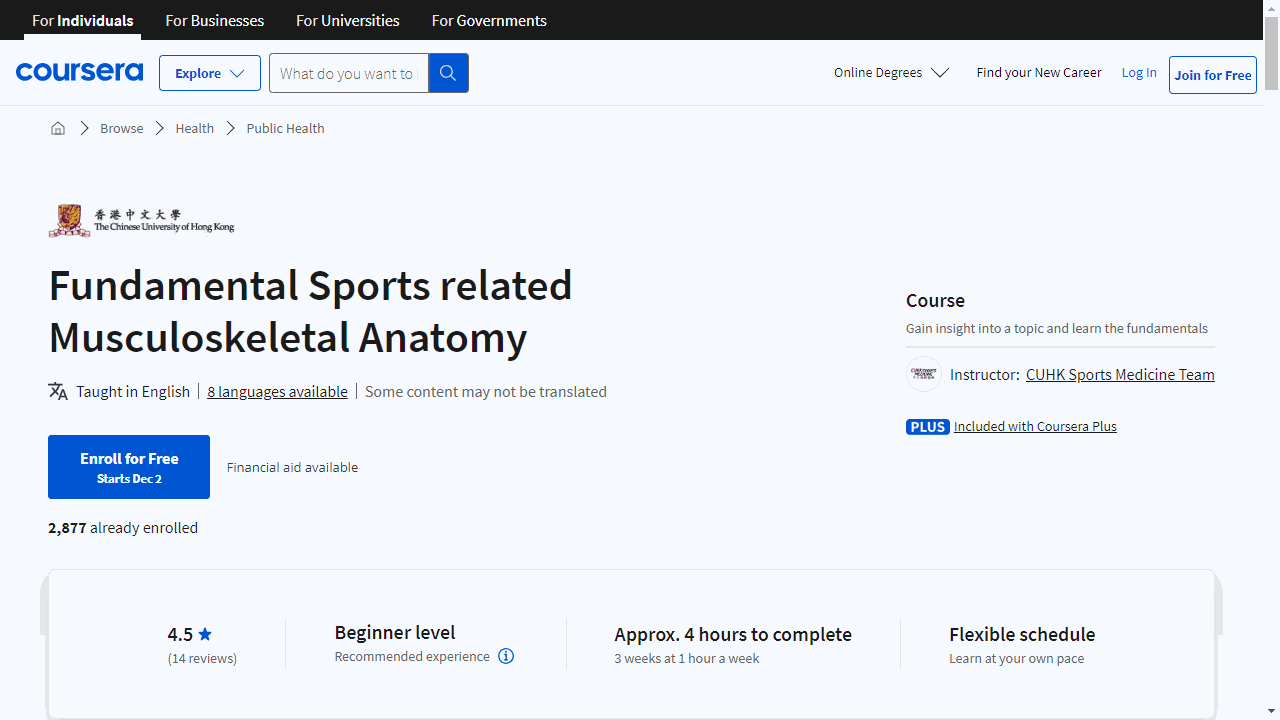Learning anatomy can be incredibly rewarding, offering a deeper understanding of the human body and its intricate systems.
Whether you’re a medical student, aspiring healthcare professional, or simply curious about how your body works, a good anatomy course can be invaluable.
However, finding the right course online can be overwhelming, with countless options available.
We understand the frustration of sifting through endless course descriptions, trying to find one that aligns with your needs and learning style.
That’s why we’ve compiled this guide to the best anatomy courses on Coursera, helping you choose the perfect fit for your learning journey.
For the best overall anatomy course, we recommend Anatomy Specialization by the University of Michigan.
This comprehensive program offers four in-depth courses covering the musculoskeletal, integumentary, cardiovascular, respiratory, urinary, nervous, gastrointestinal, reproductive, and endocrine systems.
With engaging videos, detailed anatomical images, interactive lessons, and clinical correlations, this specialization provides a well-rounded foundation in human anatomy.
But this is just the beginning.
We’ve also included courses focused on specific body regions, medical terminology, and even sports-related anatomy.
Keep reading to discover the perfect course to help you master the complexities of the human body.
Anatomy Specialization
This specialization, by the University of Michigan, offers a comprehensive look at our complex anatomical systems.
Each course is designed to build your knowledge in a specific area, ensuring a well-rounded grasp of human anatomy.
Dive into “Anatomy: Musculoskeletal and Integumentary Systems” to explore how your bones, muscles, skin, hair, and nails function and protect you.
Through engaging videos and detailed anatomical images, you’ll learn the mechanics of movement and the body’s natural defense layers.
In “Anatomy: Cardiovascular, Respiratory and Urinary Systems,” you’ll uncover the essentials of how your heart, lungs, and kidneys operate.
Interactive lessons will guide you through the vital processes of circulating blood, breathing air, and eliminating waste.
“Anatomy: Human Neuroanatomy” brings you closer to understanding the central and peripheral nervous systems.
You’ll gain insights into how your brain communicates with your body, controlling everything from sensory perception to muscle movement and the stress response.
Lastly, “Anatomy: Gastrointestinal, Reproductive and Endocrine Systems” focuses on digestion, hormone regulation, and reproduction.
Clinical correlations bring these concepts to life, emphasizing the significance of each system in maintaining overall health.
Each course in this specialization is rich with practical knowledge, from understanding joint classifications to the pathways of nerves and blood vessels.
Human Anatomy and Medical Terminology Fundamentals Specialization
This comprehensive program kicks off with “Medical Terminology, Anatomy, and Physiology Fundamentals,” where you’ll dissect medical terms to grasp their meanings, delve into the human body’s structure, and understand how diseases affect it.
Dive deeper with “The Skin, Bones, and Muscles” course, focusing on the integumentary, skeletal, and muscular systems.
You’ll learn the specific medical vocabulary for these body parts and identify common diseases that can impact them.
In “The Human Body’s Communication Systems,” you’ll unravel the complexities of the nervous and endocrine systems.
This course equips you with the terminology and knowledge to discuss conditions related to body signaling and hormonal balance.
“The Heart, Blood, and Lungs” course will guide you through the cardiovascular, immune, and respiratory systems.
You’ll gain insights into how these systems function, the medical terms that define them, and the diseases that can disrupt their harmony.
Finally, “Digestion, Micturition, and Reproduction” covers the digestive, urinary, and reproductive systems.
You’ll understand these systems’ roles, learn the language to describe their functions, and discuss prevalent diseases.
Each course is designed to build your proficiency in medical terminology and anatomy, preparing you to navigate medical records and understand the human body’s workings.
Human Anatomy & Physiology I Specialization
This specialization, by Rice University, offers a comprehensive journey through the human body, crafted to build your understanding from the ground up.
Starting with “Anatomy & Physiology: Levels of Organization,” you’ll grasp the fundamental patterns and terms essential to anatomy.
This course is your stepping stone, introducing you to the microscopic building blocks—atoms and molecules—and guiding you through their assembly into cells, tissues, and organ systems, like the skin’s role in the Integumentary System.
The second course, “Anatomy & Physiology: Support & Movement,” focuses on the skeletal and muscular systems.
Here, you’ll learn the intricacies of bones and muscles, their cooperation, and their relevance to human development and health conditions.
It’s an ideal course if you’re fascinated by the mechanics of movement or are considering a career related to physical therapy or sports medicine.
In “Anatomy & Physiology: Regulation, Integration, & Control,” you’ll delve into the nervous and endocrine systems, the command centers for body regulation.
Discover how the brain, nerves, and hormones orchestrate every action and reaction, providing insights into neurological and hormonal functions.
Each course equips you with critical skills, from anatomical terminology to physiological processes, and emphasizes their clinical relevance.
You’ll also enhance your research abilities, ensuring you can navigate and interpret scientific information effectively.
By choosing this specialization, you’re not just learning; you’re gaining a rich, applicable understanding of human anatomy and physiology from a prestigious institution.
Human Anatomy & Physiology II Specialization
This series, designed by Rice University, takes you through the intricacies of the human body, focusing on how different systems operate and their roles in health and disease.
In “Anatomy & Physiology: Fluids, Transport, and Defense,” you’ll delve into the cardiovascular and lymphatic/immune systems.
You’ll identify their key components and understand their normal functions, linking this knowledge to clinical conditions.
This course is ideal if you’re interested in how blood circulates or how the body mounts defenses against pathogens.
Moving on to “Anatomy & Physiology: Exchange and Energy,” the spotlight shifts to the respiratory and digestive systems.
Discover the pathways of air and food, learning to pinpoint the parts involved and their functions.
This course is perfect if you’re fascinated by the processes of breathing and digestion.
The final course, “Anatomy & Physiology: Filtration and Reproduction,” focuses on the urinary and reproductive systems.
You’ll explore how the body filters waste and the journey from conception to birth.
If you’re curious about kidney function or human development, this course will be enlightening.
Throughout the specialization, you’ll master anatomical terminology, physiological processes, and organ system identification.
The courses emphasize clinical relevance, preparing you to apply your knowledge in healthcare contexts.
You’ll also enhance your research and information literacy, crucial for further exploration in anatomy and physiology.
Anatomy of the Chest, Neck, Abdomen, and Pelvis
This course, by Yale University, offers a thorough exploration of these critical body areas.
You’ll start with the basics of surface anatomy, learning the external landmarks before delving into the body’s interior.
The course is hands-on, featuring physical examination techniques for the chest, neck, and abdomen, which mirror real-world medical practice.
You’ll witness actual procedures like bronchoscopy and pleuroscopy, providing a window into lung examination, and engage with heart anatomy through detailed lectures on the thorax, coronary vessels, and the heart’s conduction system.
Moving beyond the chest, the course examines the mediastinum, great vessels, and the complexities of the neck.
In the abdomen section, you’ll tackle the digestive system’s development and witness surgeries, enhancing your understanding of abdominal anatomy.
The pelvis is dissected in detail, with separate focus on male and female anatomy, the skeletal structure, and pelvic vessels and nerves.
Live procedures such as cystoscopy are included, offering a real-time view of bladder examination.
Each module concludes with a digital practical exam, ensuring you can apply what you’ve learned.
Key structures are emphasized throughout, with review activities to reinforce your knowledge.
Anatomy of the Abdomen and Pelvis; a journey from basis to clinic.
This course, by Universiteit Leiden, offers a focused exploration of the abdomen and pelvis, blending foundational knowledge with clinical application.
You’ll begin with an orientation to succeed in online learning and quickly dive into the anatomy, starting with the digestive journey from mouth to anus.
Real anatomical dissections complement your learning, providing a visceral understanding of the body’s interior.
Key to your studies will be mastering anatomical terminology and interpreting cross-sections, essential skills for any anatomy enthusiast.
The course simplifies complex concepts like the four-layer model of the gut and tissue histology, ensuring you grasp the details of the esophagus, stomach, and GI tract.
Embryology is also a highlight, revealing the developmental origins of the abdomen and pelvis.
You’ll visualize the embryonic folding process and gut rotation, gaining insights into the adult body’s layout.
The peritoneum, a vital area for surgeons, is demystified through model demonstrations and discussions on its challenging aspects.
You’ll understand its relationship with the gut and its developmental journey.
The course also emphasizes the significance of the body’s walls, including the abdominal wall and pelvic floor, detailing their protective roles and structural components.
You’ll explore the female pelvis and learn about conditions like extrauterine pregnancy.
Interactive tools like the OAH viewer bring a 3D perspective to your studies, while laparoscopy videos offer a window into surgical procedures, enhancing your understanding of normal and pathological organ states.
Pain, a critical aspect of medicine, is addressed through lessons on the nervous system, types of abdominal pain, and clinical evaluation techniques.
You’ll delve into complex topics such as abdominal aortic aneurysm and the gut-brain connection, rounding out a comprehensive educational experience.
Anatomy of the Upper and Lower Extremities
This course, by Yale University, is detailed, so be prepared for graphic content as you’ll be examining real-life images and dissections.
Starting with the lower limbs, you’ll delve into the bones, muscles, vessels, and nerves that enable movement.
Through interactive digital exams, you’ll apply your knowledge by identifying key structures in a virtual environment.
The course provides step-by-step dissection guides, complete with photos and text, to enhance your understanding of the thigh, knee, and foot.
Transitioning to the upper limbs, the course covers the intricate anatomy from your shoulders to your fingertips.
You’ll dissect the complexities of the brachial plexus and learn how nerves and blood vessels function to control movement.
The course’s practical, hands-on approach continues with more digital exams, allowing you to test your grasp of the material in a dynamic way.
Fundamental Sports-Related Musculoskeletal Anatomy
Tailored for those with an interest in sports or a curiosity about how the body works, this course, by The Chinese University of Hong Kong, offers a comprehensive look at the musculoskeletal system.
You’ll start with the basics of anatomy, learning essential terms and abbreviations to navigate the subject with ease.
The course then guides you through the intricacies of the musculoskeletal system, giving you a clear understanding of how your bones and muscles interact to facilitate movement.
Focusing on the spine, you’ll gain insights into its crucial role in flexibility and strength.
The sections on the thoracic region and upper limbs will equip you with knowledge about the mechanics of your arms and hands, essential for any physical activity.
The course also delves into the pelvic and hip regions, the driving force behind many movements, and provides a detailed look at knee anatomy, vital for injury prevention.
Lastly, you’ll study the foot and ankle, your body’s support system, to understand how they bear your weight and enable mobility.
With targeted further reading, you’ll have the opportunity to deepen your understanding at your own pace.
